FRIDAY, JUNE 19
■ Leo the Lion is mostly a constellation of late winter and spring. But he's not gone yet. All week as twilight ends, look due west, somewhat low, for Regulus, Leo's brightest and now lowest star: the forefoot of the Lion stick figure.
The Sickle of Leo extends upper right from Regulus, as shown in the second scene below. The rest of the Lion's constellation figure extends for almost three fists to the upper left, to his tail star Denebola, the highest. He'll soon be treading away into the sunset.
SATURDAY, JUNE 20
■ The June solstice arrives today at 5:44 p.m. EDT (21:44 UT). This is when the Sun reaches its northernmost declination in Earth's sky and begins its six-month return southward. Summer begins in the Northern Hemisphere, winter in the Southern Hemisphere.
For us northerners, this is the longest day and shortest night of the year.
It's also the day when (in the north temperate latitudes) the midday Sun passes the closest it ever can to being straight overhead, and thus when your shadow becomes the shortest it can ever be at your location. This happens at local apparent [solar] noon, which is probably rather far removed from noon in your civil (clock) time.
And if you have a good west-northwest horizon (again in mid-northern latitudes), mark very precisely where the last bit of the Sun sets. In a few days you should be able to detect that the Sun is again starting to set a just little south (left) of that point.
SUNDAY, JUNE 21
■ After dark look southeast, fairly low, for orange Antares, "the Betelgeuse of summer." Both are 1st-magnitude "red" supergiants. Around and to the upper right of Antares are the other, whiter stars of upper Scorpius forming its distinctive shape. The rest of the Scorpion curls down toward the horizon.
And right after dark, spot Arcturus way up high toward the south. Three fists below it is Spica. A fist and a half to Spica's lower right, four-star Corvus, the springtime Crow, is heading down and away as spring draws to a close.
■ New Moon (exact at 2:41 a.m. on this date EDT).
■ Annular eclipse of the Sun for parts of east-central Africa, the southern Arabian Peninsula, Pakistan, northern India, mainland China, Taiwan, and the Pacific. Partial eclipse of the Sun for nearly all of southeastern Europe, Africa, and Asia. Map and details. Timetables for your location.
MONDAY, JUNE 22
■ In bright twilight look for the slim crescent Moon, less then two days old, low in the afterglow of sunset. It's lower left of Pollux and Castor, as shown below. Bring binoculars.
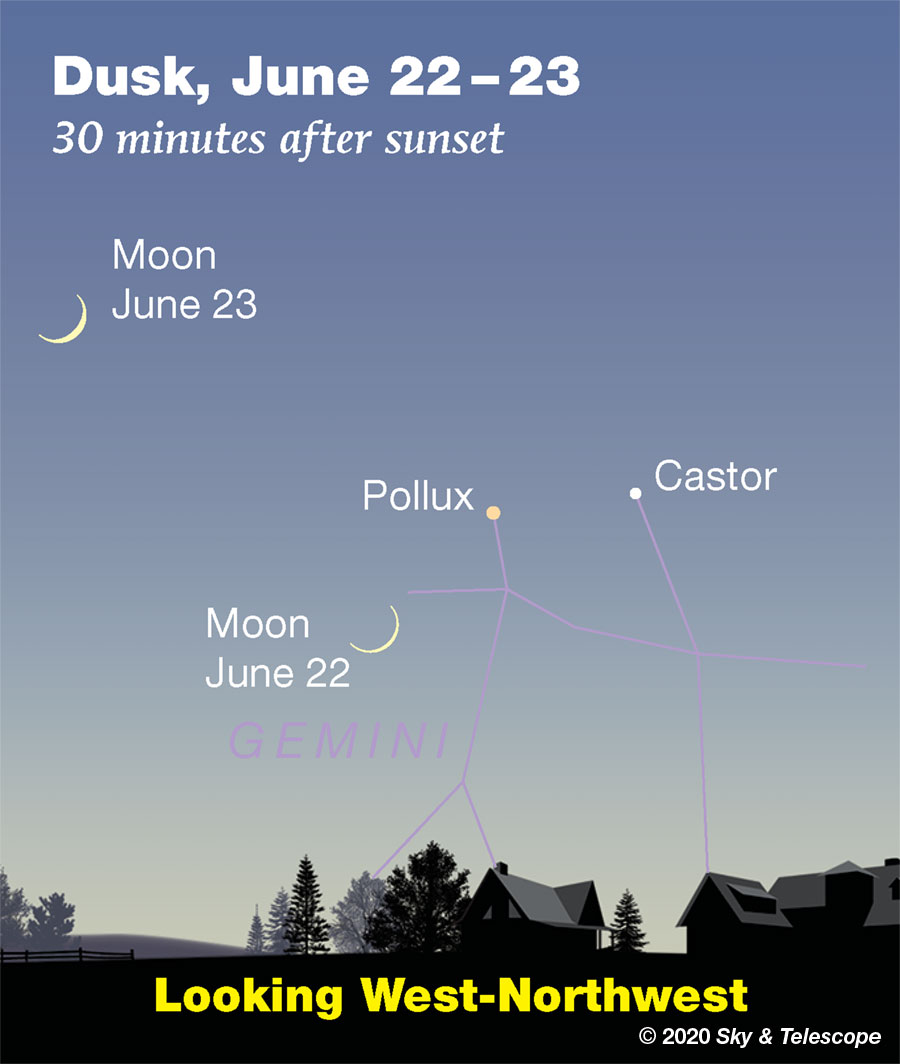
TUESDAY, JUNE 23
■ The central stars of the constellation Lyra, forming a small triangle and parallelogram, dangle to the lower right from bright Vega high in the east. The two brightest stars of the pattern, after Vega, are the two forming the bottom of the parallelogram: Beta and Gamma Lyrae, or Sheliak and Sulafat. They're currently lined up vertically. Beta is the one on top.
Beta Lyrae is an eclipsing binary star. Compare it to Gamma whenever you look up at Lyra. Normally Beta is only a trace dimmer than Gamma. Sooner or later, you'll probably catch Beta when it is definitely fainter than usual.
WEDNESDAY, JUNE 24
■ Look left of the Moon for Regulus in late twilight, as shown below.
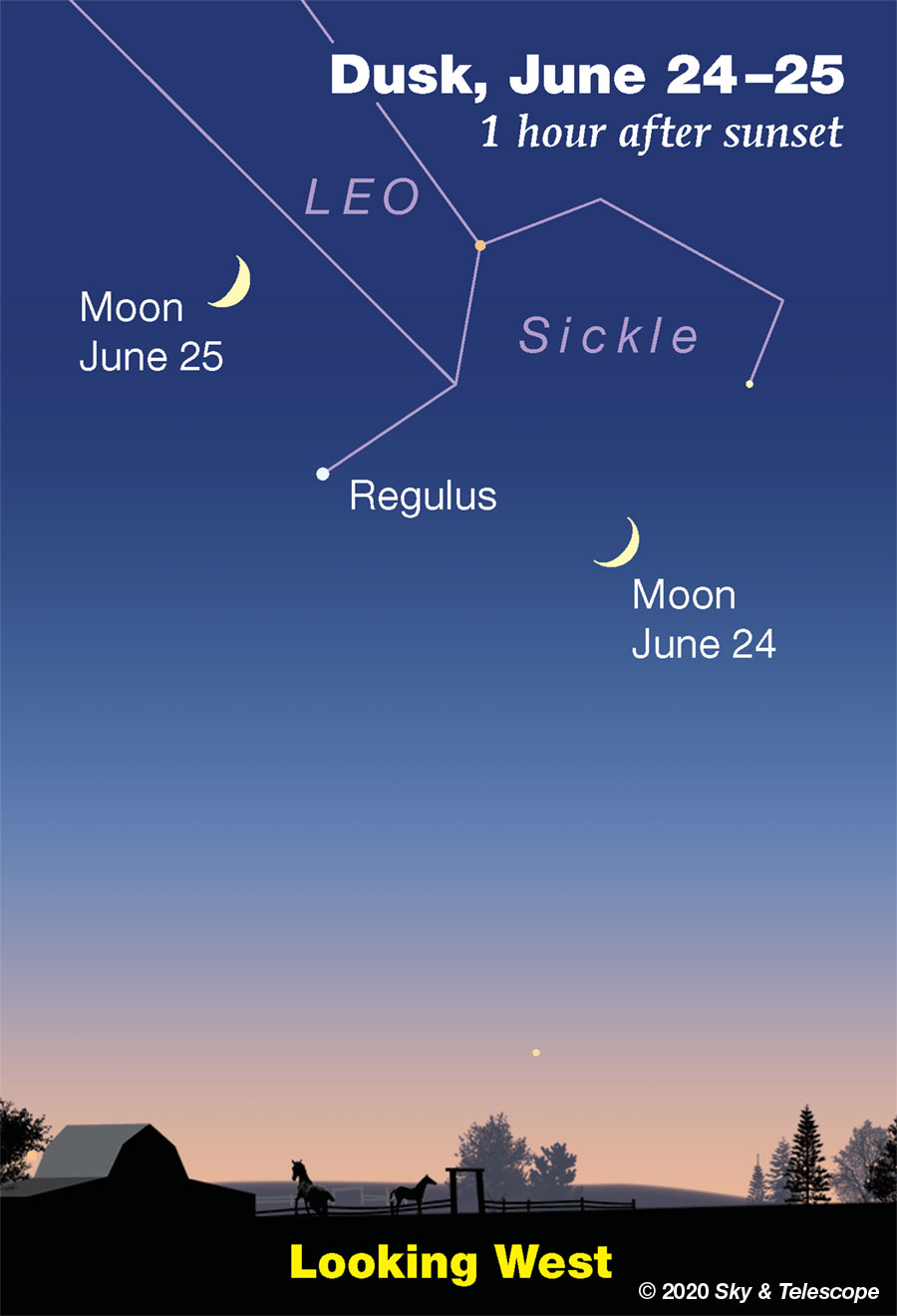
THURSDAY, JUNE 25
■ Now spot Regulus to the Moon's lower right, as shown above.
■ As evening grows late, even the lowest star of the big Summer Triangle shines fairly high in the east-southeast. That's Altair, a good three or four fists at arm's length below or lower right of Vega.
Look left or lower left of Altair, by hardly more than one fist, for the compact little constellation Delphinus, the Dolphin.
And by that time, look for Jupiter and Saturn very low three fists to Altair's lower right.
FRIDAY, JUNE 26
■ Every morning now, Venus is getting a little higher and easier to spot in the east-northeast as dawn brightens, as shown below.
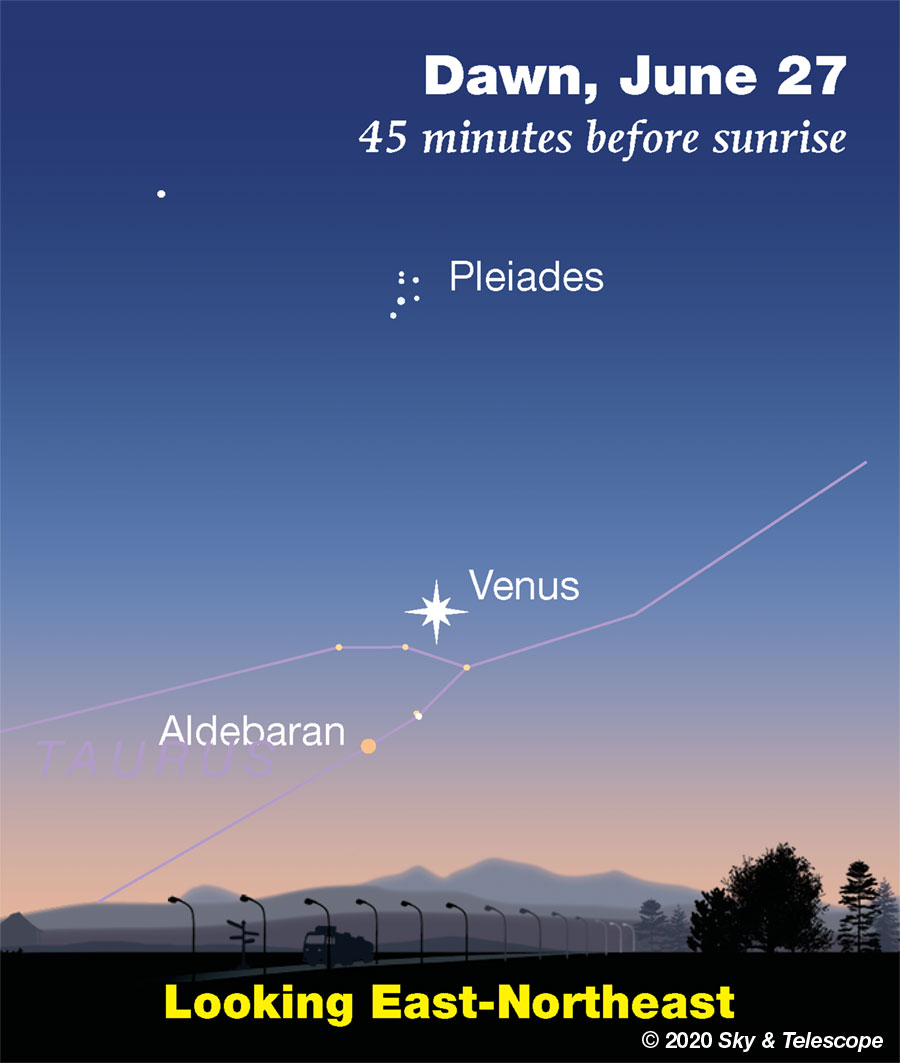
■ This evening, the nearly first-quarter Moon shines in the hind feet of the Leo stick figure (for North America), about 8° under Leo's 2nd-magnitude tail-tip star, Denebola.
Denebola forms an almost perfectly equilateral triangle with brighter Spica off to its left and Arcturus, brighter still, above them. All three sides of the triangle are close to 35° long (35.3°, 35.1°, and 32.8°). This has been called the Spring Triangle, a name that certainly fits. Let's see if we can get it to stick.
SATURDAY, JUNE 27
■ First-quarter Moon tonight and tomorrow. (The Moon is exactly first-quarter at 4:16 a.m. Sunday morning EDT.) This evening the Moon lies partway along the line from Denebola, right of the Moon, to brighter Spica, off to the Moon's left.
This Week's Planet Roundup
Mercury is lost in the sunset.
Venus is low in the dawn; look for it just above the east-northeast horizon, as shown above. Look early enough before dawn grows bright, and you may be able to catch the Pleiades 9° above it. Binoculars help.
Venus is on its way up to a fine showing as the bright Morning Star through summer and fall.
Mars rises in the east around 1 a.m. daylight saving time, shining bright orange (magnitude –0.4) at the Aquarius-Pisces border. Watch for it to clear the horizon lower right of the Great Square of Pegasus. By the first light of dawn, Mars shines high and prominent in the southeast.
In a telescope Mars has grown to 11 arcseconds in apparent diameter; we're approaching it as Earth speeds along in our faster orbit around the Sun. Mars is as gibbous as it gets, 84% sunlit. Look for the bright South Polar cap and for subtler dark surface markings.
Mars will appear fully twice this diameter when it passes closest by Earth around opposition in the first half of October.
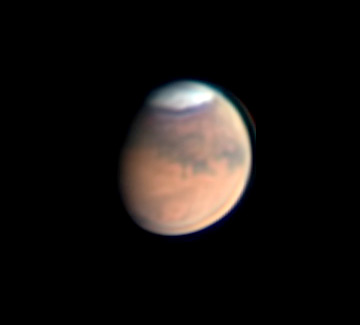
Jupiter and Saturn (magnitudes –2.7, and +0.3, respectively) now rise around the end of twilight: Jupiter first, then dimmer Saturn following about 20 minutes behind, lower left of Jupiter. They're 5½° apart. Farther to Jupiter's right, the Sagittarius Teapot rests upright.
The two giant planets shine at their highest and telescopic best around 2 or 3 a.m. daylight-saving time. They straddle the border of Sagittarius and Capricornus. Jupiter will reach opposition on the night of July 13th, Saturn on July 20th.
Keep up with the telescopic interplay of Jupiter's moons and their shadows, and the transit times of Jupiter's Great Red Spot, with the June Sky & Telescope, page 50.
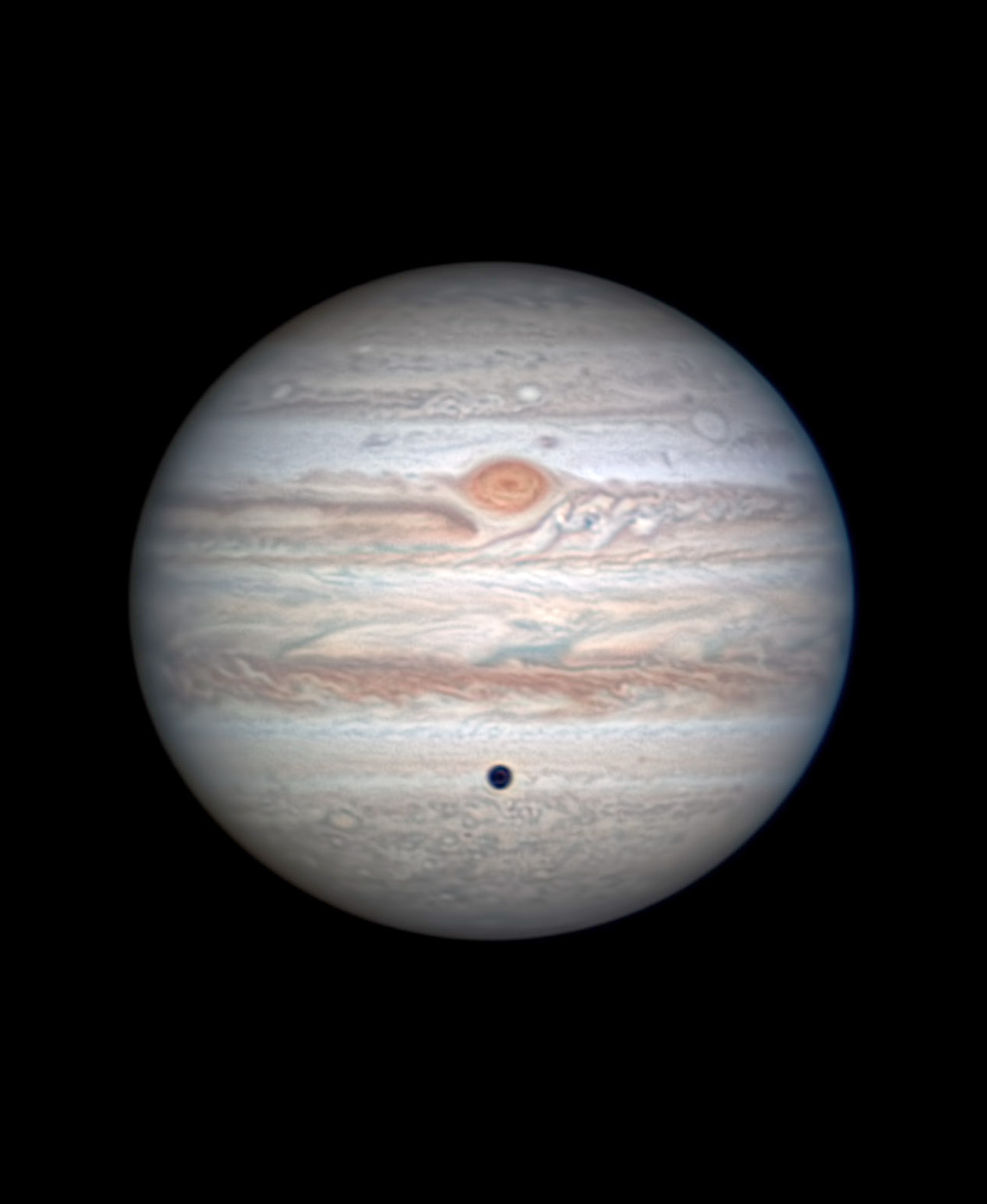
Go continues, "The Great Red Spot looks very interesting today. ... The wake of the GRS shows very complex turbulence. The 'chimney' north of the GRS [just below it and bending left in this south-up image] is now open. SE [upper right] of the GRS is the area of Clyde's spot. Oval BA can be seen rising." That's the large gray-white spot near the upper-right limb. "Its dark ring is well resolved. The North Equatorial Belt still looks very strange, especially the light NEBn."
Uranus (magnitude 5.8, in Aries) is very low in the east just before dawn.
Neptune (magnitude 7.9, in Aquarius) is well up in the southeast before dawn begins, in the vicinity of Mars.
All descriptions that relate to your horizon — including the words up, down, right, and left — are written for the world's mid-northern latitudes. Descriptions that also depend on longitude (mainly Moon positions) are for North America.
Eastern Daylight Time (EDT) is Universal Time (UT, UTC, GMT, or Z time) minus 4 hours.
Want to become a better astronomer? Learn your way around the constellations. They're the key to locating everything fainter and deeper to hunt with binoculars or a telescope.
This is an outdoor nature hobby. For an easy-to-use constellation guide covering the whole evening sky, use the big monthly map in the center of each issue of Sky & Telescope, the essential magazine of astronomy.
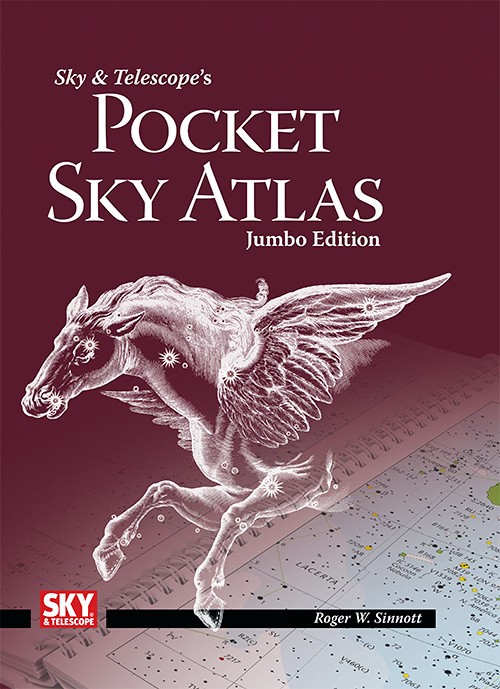
Once you get a telescope, to put it to good use you'll need a detailed, large-scale sky atlas (set of charts). The basic standard is the Pocket Sky Atlas (in either the original or Jumbo Edition), which shows stars to magnitude 7.6.
Next up is the larger and deeper Sky Atlas 2000.0, plotting stars to magnitude 8.5; nearly three times as many. The next up, once you know your way around, are the even larger Interstellarum atlas (stars to magnitude 9.5) or Uranometria 2000.0 (stars to magnitude 9.75). And read how to use sky charts with a telescope.
You'll also want a good deep-sky guidebook, such as Sky Atlas 2000.0 Companion by Strong and Sinnott, or the bigger (and illustrated)Night Sky Observer's Guide by Kepple and Sanner.
Can a computerized telescope replace charts? Not for beginners, I don't think, and not on mounts and tripods that are less than top-quality mechanically, meaning heavy and expensive. And as Terence Dickinson and Alan Dyer say in their Backyard Astronomer's Guide, "A full appreciation of the universe cannot come without developing the skills to find things in the sky and understanding how the sky works. This knowledge comes only by spending time under the stars with star maps in hand."
![]() Audio sky tour. Out under the evening sky with your earbuds in place, listen to Kelly Beatty's monthly podcast tour of the heavens above. It's free.
Audio sky tour. Out under the evening sky with your earbuds in place, listen to Kelly Beatty's monthly podcast tour of the heavens above. It's free.
 6
6








Comments
Ernesto
June 20, 2020 at 8:23 am
A minor grammatical error on This Week's Sky at a Glance June 22nd...
the word "then" is used where is should be the word "than"
■ In bright twilight look for the slim crescent Moon, less then two days old, low in the afterglow of sunset.
It should read "less than two days old"
Thank you
You must be logged in to post a comment.
Rod
June 22, 2020 at 7:35 am
mary beth, after some rain the other day, I was out early this morning enjoying views of Antares and M4 globular cluster in the same filed of view. A note from my stargazing log 🙂 [Observed 0030-0110 EDT or 0430-0510 UT. New Moon 21-Jun-2020 0641 UT. I enjoyed some lower power, wide field views of Antares and M4 in the same FOV. 32-mm plossl used at 31x. Some faint, outer stars visible in M4. This would be a great sight using the 10-inch with 35-mm eyepiece. The fields were much too wet tonight and early this morning from all the rain on Saturday and a bit more on Sunday afternoon that passed the area to setup my 10-inch Newtonian. It was easier to use the 90-mm refractor on the altitude-azimuth tripod. Viewing Antares with faint stars around the FOV and M4 together, very enjoyable sight. I used 10x50 binoculars too and also enjoyed this view but the telescope was brighter image.]
You must be logged in to post a comment.
mary beth
June 22, 2020 at 3:52 pm
Glad you got a break from the clouds to enjoy the ‘rival of mars‘!! Getting to the Meridian before midnight now and so I am really enjoying its pilgrimage. We have rain all week and then the Sahara dust is going to get here so thanks will be a little dim even if it’s clear. However if it helps to keep hurricanes away by lowering the ocean temperature. I’m off for the Dust! it might temporarily clear off tonight. If so I’ll give you a good report tomorrow. Hope you enjoyed the summer solstice!
You must be logged in to post a comment.
greg glendening
June 26, 2020 at 1:26 am
sorry about this, mary beth:
“However if it helps to keep hurricanes away by lowering the ocean temperature, I’m all for the Dust!”
“I’m all for...” — not “I’m off for.”
Thanks,
starry starry night
You must be logged in to post a comment.
mary beth
June 26, 2020 at 12:50 pm
Spell ‘wreck’ got me on that one lol
You must be logged in to post a comment.
mary beth
June 26, 2020 at 12:51 pm
Dang!! I think the grammar police have invaded!!
You must be logged in to post a comment.
You must be logged in to post a comment.